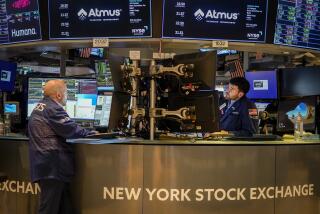It’s just no use trashing junk bonds
Tired of being on the outside looking in at the scads of money being made by corporate takeover artists and hedge funds?
It’s easy enough to be part of those booms. By buying into mutual funds that own either high-yield bonds or high-yield bank loans, you can invest with the new movers and shakers in finance, who are ravenous for cash to bankroll their escapades.
But to jump in today is to ignore the advice of Wall Street veterans who say the risks are too worrisome, and the potential investment returns too low, to justify joining the big-money crowd.
The problem with those warnings is that they were out there a year ago too -- and you would have been better off paying no attention to them.
“Last year we were all wrong” in advising caution, says King Penniman, head of high-yield bond research at KDP Investment Advisors in Montpelier, Vt.
The average high-yield (or “junk”) bond mutual fund in 2006 had a 10.1% total return, according to Morningstar Inc. That gain, which counts interest earnings plus capital appreciation, was more than twice the return on ultra-low-risk money market funds.
We’re in the thick of a period when debt is a good thing rather than a bad thing, at least in the corporate world. And the riskier the debt, the more investors want it.
It’s easy to see why. The average total return on corporate bonds rated CCC -- considered highly speculative -- was 18.6% last year, according to bond-rating firm Standard & Poor’s. About 44% of the return came from price appreciation as investors bid the bonds up.
By contrast, BB-rated bonds, which are two quality grades above CCC-rated bonds, produced an average total return of 9.9%.
The hunger for risk has only deepened in the new year. The average annualized yield on an index of 100 junk issues tracked by KDP fell to 7.17% last week, the lowest since mid-2005. Junk yields are falling even as yields on high-quality bonds, such as U.S. Treasury issues, are rising.
There is a self-sustaining cycle at work here for the moment. The global economy has been so strong in recent years that few companies, even those that are loaded with debt, have had trouble paying their obligations.
The default rate on junk bonds, meaning the percentage of outstanding issues on which interest payments had been suspended, fell to a record-low 1.3% in 2006, S&P; data show. Just five years earlier the default rate was 10.5%.
A junk security is a bond issued by any company rated below investment grade -- a list that includes such well-known names as Ford Motor Co., Eastman Kodak Co. and Pier 1 Imports Inc.
The paucity of defaults by junk issuers makes owning their bonds or other low-rated debt seem less dangerous. As the risk appears to ebb, more investors step up to buy bonds or to fund loans to low-rated companies rather than settle for less lucrative yields on higher-quality debt.
And with easy access to credit, some companies that otherwise might have faced debt trouble can paper it over with new money, thereby staving off the potential for default.
As Jim Grant, editor of Grant’s Interest Rate Observer newsletter in New York, put it in a report this month: “It’s hard to default when lenders keep writing you checks.”
Ready access to credit has been crucial for the boom in corporate takeover activity, including leveraged buyouts led by private equity investors, those pools of capital from the well-heeled. As the term implies, a leveraged buyout is mostly financed with borrowed money.
New junk bond issuance last year reached a record high of $136 billion, up from $92 billion in 2005.
Buyouts nowadays often are financed with a combination of high-yield bonds and floating-rate bank loans. The banks then parcel the loans out to investors, including a relatively new breed of mutual funds that specialize in buying pieces of such loans.
Assets of those mutual funds swelled from $16 billion at the end of 2005 to $24.6 billion by the end of last year, according to Lipper Inc. The average bank-loan fund generated a return of 6.5% for investors in 2006, well above what high-quality bond funds paid.
As for hedge funds, many of which constantly search for a way to make more money than plain-vanilla investments afford, junk bonds and high-yield loans are a natural place to turn. They provide the chance to earn better yields than what low-risk bonds pay out.
And if hedge funds buy bonds with borrowed money -- leverage on leverage, as it were -- their returns can be magnified.
A hefty supply of junk bonds also allows hedge funds and other investors to speculate in the ballooning market for so-called derivatives -- securities or privately negotiated contracts whose value is derived from price moves in bonds, stocks or other investments.
For example, using derivative instruments known as credit default swaps, investors can either hedge against the risk that a company could default on its debt or they can take the opposite side -- betting that default is inevitable (and if it is, the investor with that side of the swap is supposed to profit).
As buyers of junk bond funds and bank loan funds, individual investors are in the game with the private equity players and the hedge funds.
But the private equity chieftains and hedge fund managers obviously are calling the shots. The small investor, with his or her money, is an enabler: You’re helping takeover deals get done, and you’re providing some of the raw material for the derivatives market. And, hopefully, you’re earning a decent return.
The sneaking suspicion you ought to have, however, is that the bigger players hope to ultimately profit at the expense of the investors who are rushing to provide limitless credit.
Bruce Monrad, who manages the Northeast Investors Trust junk bond fund in Boston, laments private equity investors’ increasing efforts to weaken so-called covenants in bond financings. Covenants, such as limits on how much additional debt a company can take on, are supposed to keep company managers from making financial moves that could raise the default risk on existing debt.
As investors, Monrad says, “we’re pushing back on covenants from [terms] that were unattractive to us in the first place.”
And every debt holder knows, of course, that the goal of private equity buyers is to cash out of the companies they’re buying in a few years or less, by selling them to other companies or taking them public again.
At that point, what happens to the debt holders isn’t the private equity investors’ concern.
“The private equity guy who’s getting the capital to do these deals is not going to be there when the problems hit” for companies too deep in debt, says KDP’s Penniman.
Ray Kennedy, a veteran high-yield bond portfolio manager at Pacific Investment Management Co. in Newport Beach, says all of the concerns raised by his peers are legitimate.
With junk yields at current levels, “we hate it,” Kennedy says.
Even so, he adds, “we may be here for a while.”
Every mania has a fundamental underpinning, including this one. If the global economy continues to expand, corporate bond default rates may stay near rock bottom. With yields on Treasury bonds mostly below 5%, investors who are starved for return may figure that junk bonds paying 7% or better are well worth the risk.
These returns are low, but they were even lower a couple of years ago. In December 2004, the KDP junk index yield bottomed at 6.35%.
At these yield levels, any unpleasant surprise -- say, a stock market plunge or unexpected financial problems at a debt-laden company -- could trigger a rapid sell-off in junk bonds, said Edward Altman, a New York University finance professor who is one of the leading academic authorities on the junk market.
The last big sell-off occurred in the spring and took the KDP index yield from 7.65% to 8.27% in six weeks.
And then the buyers poured in again.
All great parties come to an end. But for now, the line to get into this high-risk-debt party still looks like it’s out the door and down the street.
More to Read
Inside the business of entertainment
The Wide Shot brings you news, analysis and insights on everything from streaming wars to production — and what it all means for the future.
You may occasionally receive promotional content from the Los Angeles Times.










